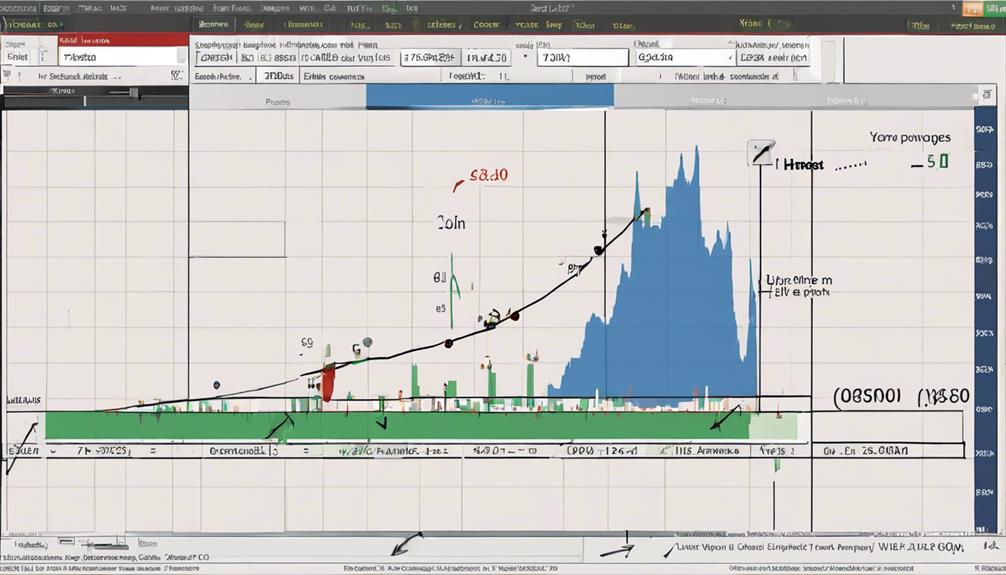If you've ever found the Relative Strength Index (RSI) to be complex or daunting, fear not. The step-by-step guide simplifies the process, making it accessible even to those new to technical analysis.
By following the sequential breakdown of calculations, you'll uncover the method behind this popular indicator, enabling you to harness its power in your trading endeavors.
Understanding how to calculate RSI is just the beginning – the real value lies in interpreting its implications for your investment decisions.
Stay tuned to unravel the mystery behind this essential tool in financial analysis.
Understanding Relative Strength Index
If you're new to technical analysis, understanding the Relative Strength Index (RSI) is essential for gauging market momentum. The RSI is an indicator that measures the strength of price movements, helping traders identify overbought and oversold conditions in the market.
With values ranging from 0 to 100, the RSI compares the average gains and losses over a specific period, offering insights into the historical price data of securities. Traders use the RSI to evaluate potential trend reversals and determine the strength of securities.
Values above 70 indicate overbought conditions, suggesting a possible price reversal to the downside, while values below 30 signal oversold conditions, indicating a potential price reversal to the upside. Understanding the RSI is crucial for making informed trading decisions.
Initial Step for RSI Calculation

Selecting an appropriate time period, typically around 14 days, marks the initial step in calculating the Relative Strength Index (RSI). When determining this period, consider your trading strategies and prevailing market conditions.
Analyzing historical price data within this timeframe is crucial for deriving accurate RSI values. Here's how to begin the RSI calculation process:
- Choose a time period, often 14 days, for RSI analysis.
- Calculate the average gains and losses in the price movements.
- Adjust the time period based on your trading style and current market conditions.
Calculating Relative Strength Value

To calculate the Relative Strength Value, analyze the average gains and losses over a specified period to determine the relative strength values. This involves comparing the average up moves to the average down moves to calculate the RS value.
The RS value obtained is then inserted into the RSI formula to derive the Relative Strength Index (RSI). RSI values ranging between 0 and 100 offer insights into the security's momentum and potential overbought or oversold conditions.
Understanding the RS value calculation process is crucial for accurate RSI interpretation and making informed trading decisions. By grasping these calculations, investors can better gauge the market sentiment and identify potential entry or exit points based on the RSI readings.
Deriving Relative Strength Index (RSI)

Analyzing the Relative Strength Value sets the foundation for deriving the Relative Strength Index (RSI) by comparing average gains and losses over a specified period. When calculating the RSI, consider the following steps:
- Averaging Gains and Losses: Sum up gains and losses separately over the chosen period and then divide them by the number of periods to get the average values.
- Calculating RSI: Use the formula RSI = 100 – [100 / (1 + RS)], where RS is the ratio of average gain to average loss.
- Interpreting RSI Values: RSI values between 0 and 100 help identify overbought and oversold conditions, signaling potential trend reversals and guiding your trading decisions effectively.
What Are the Key Steps to Calculate Relative Strength Index?
To calculate relative strength index insights, start by choosing a time frame, typically 14 periods. Then, calculate the average gain and average loss over those periods. Next, calculate the relative strength (RS) by dividing the average gain by the average loss. Finally, use the RS to calculate the RSI.
Evaluating RSI Value Interpretation

Considering the Relative Strength Index (RSI) values above 70 as indications of overbought conditions and values below 30 as suggestive of oversold conditions is crucial in evaluating market trends and potential trading opportunities.
RSI can help you determine optimal times to buy or sell securities based on these overbought and oversold levels. By analyzing RSI readings, you can anticipate potential trend reversals and assess the strength of existing trends.
Furthermore, identifying RSI divergences, including positive-negative reversals and swing rejections, offers valuable insights into interpreting signals for making informed trading decisions.
Ultimately, RSI serves as a valuable tool in predicting security performance and validating trends, providing a comprehensive framework for assessing market conditions and optimizing trading strategies.
Frequently Asked Questions
How Do You Calculate Relative Strength?
To calculate relative strength, divide the average up moves by the average down moves within a specified period. This division yields the Relative Strength (RS), crucial for determining overbought and oversold conditions through the Relative Strength Index (RSI) formula.
What Is RSI for Dummies?
RSI for dummies simplifies market momentum analysis. It's a 0-100 scale measuring overbought and oversold conditions, aiding trend reversal prediction. Values above 70 signal overbought, below 30 mean oversold. Understanding RSI basics is crucial for informed trading decisions.
How Do You Calculate Relative Strength Index in Excel?
To calculate Relative Strength Index in Excel, you determine average gains and losses over a specific period. Use Excel formulas like AVERAGE and IF to set up columns for price changes, average gains, losses, and final RSI value.
How Do You Set up Relative Strength Index?
Craft your trading prowess by setting up Relative Strength Index deftly. Sum gains on high tides, divide by the chosen period. Calculate losses on low ebbs, divide too. Compute RS, then wield the RSI formula for market insights.
Conclusion
In conclusion, mastering the calculation of the Relative Strength Index is like learning to dance to the rhythm of the market. By following the step-by-step guide and interpreting RSI values accurately, traders can navigate the ups and downs of financial markets with precision and confidence.
Understanding the nuances of RSI calculations is key to making informed decisions and staying ahead of market trends. Keep practicing and honing your skills to become a skilled RSI analyst.
